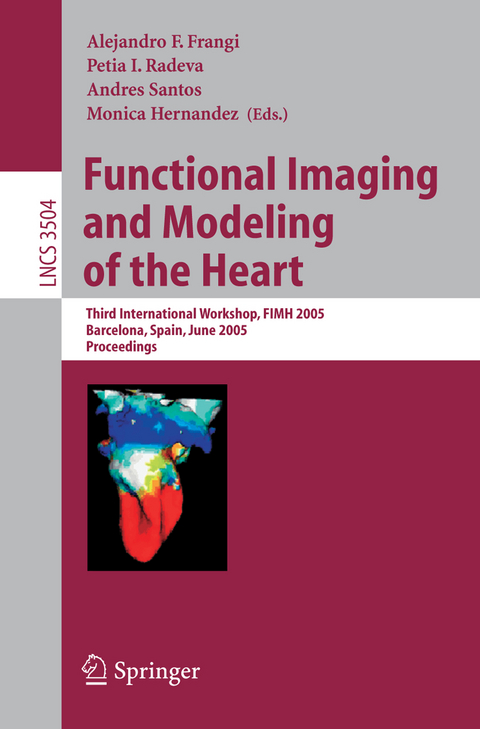
Functional Imaging and Modeling of the Heart
Springer Berlin (Verlag)
978-3-540-26161-2 (ISBN)
Modeling of the Heart - Anatomy Extraction and Description.- Multi-surface Cardiac Modelling, Segmentation, and Tracking.- Analysis of the Interdependencies Among Plaque Development, Vessel Curvature, and Wall Shear Stress in Coronary Arteries.- Automated Segmentation of X-ray Left Ventricular Angiograms Using Multi-View Active Appearance Models and Dynamic Programming.- SPASM: Segmentation of Sparse and Arbitrarily Oriented Cardiac MRI Data Using a 3D-ASM.- Combining Active Appearance Models and Morphological Operators Using a Pipeline for Automatic Myocardium Extraction.- Long-Axis Cardiac MRI Contour Detection with Adaptive Virtual Exploring Robot.- A Deterministic-Statistic Adventitia Detection in IVUS Images.- Trajectory Planning Applied to the Estimation of Cardiac Activation Circuits.- A Functional Heart Model for Medical Education.- Artificial Enlargement of a Training Set for Statistical Shape Models: Application to Cardiac Images.- Towards a Comprehensive Geometric Model of the Heart.- Automatic Cardiac 4D Segmentation Using Level Sets.- Level Set Segmentation of the Fetal Heart.- Supporting the TECAB Grafting Through CT Based Analysis of Coronary Arteries.- Electro-Physiology, Electro- and Magnetography.- Clinical Validation of Machine Learning for Automatic Analysis of Multichannel Magnetocardiography.- Hypertrophy in Rat Virtual Left Ventricular Cells and Tissue.- Virtual Ventricular Wall: Effects of Pathophysiology and Pharmacology on Transmural Propagation.- Electrophysiology and Tension Development in a Transmural Heterogeneous Model of the Visible Female Left Ventricle.- Reentry Anchoring at a Pair of Pulmonary Vein Ostia.- A Method to Reconstruct Activation Wavefronts Without Isotropy Assumptions Using a Level Sets Approach.- MagnetocardiographicImaging of Ventricular Repolarization in Rett Syndrome.- Insights into Electrophysiological Studies with Papillary Muscle by Computational Models.- Induced Pacemaker Activity in Virtual Mammalian Ventricular Cells.- Transvenous Path Finding in Cardiac Resynchronization Therapy.- Methods for Identifying and Tracking Phase Singularities in Computational Models of Re-entrant Fibrillation.- Estimating Local Apparent Conductivity with a 2-D Electrophysiological Model of the Heart.- Monodomain Simulations of Excitation and Recovery in Cardiac Blocks with Intramural Heterogeneity.- Spatial Inversion of Depolarization and Repolarization Waves in Body Surface Potential Mapping as Indicator of Old Myocardial Infarction.- Dissipation of Excitation Fronts as a Mechanism of Conduction Block in Re-entrant Waves.- Wavebreaks and Self-termination of Spiral Waves in a Model of Human Atrial Tissue.- Calcium Oscillations and Ectopic Beats in Virtual Ventricular Myocytes and Tissues: Bifurcations, Autorhythmicity and Propagation.- Modeling of the Cardiac Mechanics and Functions.- Left Ventricular Shear Strain in Model and Experiment: The Role of Myofiber Orientation.- Cardiac Function Estimation from MRI Using a Heart Model and Data Assimilation: Advances and Difficulties.- Assessment of Separation of Functional Components with ICA from Dynamic Cardiac Perfusion PET Phantom Images for Volume Extraction with Deformable Surface Models.- Detecting and Comparing the Onset of Myocardial Activation and Regional Motion Changes in Tagged MR for XMR-Guided RF Ablation.- Suppression of IVUS Image Rotation. A Kinematic Approach.- Computational Modeling and Simulation of Heart Ventricular Mechanics from Tagged MRI.- A Realistic Anthropomorphic Numerical Model of the Beating Heart.- Multi-formalism Modelling of Cardiac Tissue.- Analysis of Tagged Cardiac MRI Sequences.- Fast Spatio-temporal Free-Form Registration of Cardiac MR Image Sequences.- Comparison of Cardiac Motion Fields from Tagged and Untagged MR Images Using Nonrigid Registration.- Tracking of LV Endocardial Surface on Real-Time Three-Dimensional Ultrasound with Optical Flow.- Cardiac Motion Estimation.- Dense Myocardium Deformation Estimation for 2D Tagged MRI.- A Surface-Volume Matching Process Using a Markov Random Field Model for Cardiac Motion Extraction in MSCT Imaging.- Evaluation of Two Free Form Deformation Based Motion Estimators in Cardiac and Chest Imaging.- Classification of Segmental Wall Motion in Echocardiography Using Quantified Parametric Images.
| Erscheint lt. Verlag | 31.5.2005 |
|---|---|
| Reihe/Serie | Lecture Notes in Computer Science | Theoretical Computer Science and General Issues |
| Zusatzinfo | XVI, 496 p. |
| Verlagsort | Berlin |
| Sprache | englisch |
| Maße | 152 x 229 mm |
| Gewicht | 708 g |
| Themenwelt | Informatik ► Grafik / Design ► Digitale Bildverarbeitung |
| Schlagworte | 3D-Imaging • Bioengineering • Cardiac Imaging • Cardiac Modeling • Cardiology • classification • Computed tomography (CT) • Hardcover, Softcover / Informatik, EDV/Informatik • HC/Informatik, EDV/Informatik • HC/Medizin/Klinische Fächer • Heart Modeling • Herz (anatom.) • Herz (Anatomie) • Image Processing • learning • Level Sets • magnetocardiography • medical data processing • Medical Imaging • MRI • MRI sequences • Radiology • robot • Segmentation • Simulation • therapy • Ultrasound • XMR |
| ISBN-10 | 3-540-26161-3 / 3540261613 |
| ISBN-13 | 978-3-540-26161-2 / 9783540261612 |
| Zustand | Neuware |
| Haben Sie eine Frage zum Produkt? |
aus dem Bereich


